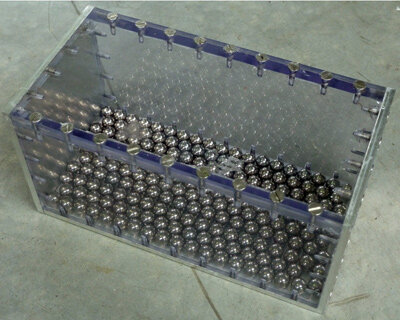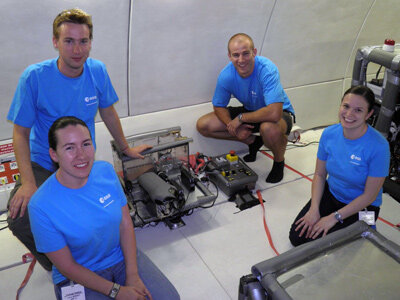Meet the teams
Four teams of postgraduate students flew their experiments during the 2011 'Fly Your Thesis!' campaign. Here is an introduction to the British team.
![]()
GRAPPA team - Gravitationless Accretion of Protoplanetary Bodies and Rubble Pile Asteroids![]()
![]()
| University | University of Leicester, United Kingdom |
| Endorsing professor |
Dr. Graham Wynn University of Leicester |
| ELGRA mentor |
Dr. Daniel Beysens Ecole Supérieure de Physique et Chimie Industrielles de la ville de Paris |
| Team |
David Gray Charlotte Feldman Laura Brandt Fergus Wilson |

Current models of solar system formation assume that planetary accretion occurs within the protoplanetary disc of the solar nebula left over from the formation of the Sun. As dust grains collide they coalesce into larger bodies, and the terminal velocities of these accreting bodies in the solar nebula grow with their mass. The relative velocity between an impactor of diameter 1 cm and a target of diameter 100 cm can be estimated to be 100 m/s, a velocity at which a 10 g impactor has sufficient kinetic energy to shatter 16 g of solid rock. It is not clear how accretion can proceed if impacts have enough energy to not only shatter the impact target, but also remove the shattered material from its extremely shallow gravitational well.
The student team believes that a kinetic liquid condensation mechanism may be relevant in planet and asteroid accretion mechanisms. Their science goal is to demonstrate experimentally the accretion mechanism of kinetic liquid condensation for silicate, metallic and metallic oxide granular materials.

By varying the mean excitation energy of the granular material and the particle size and density, a phase diagram for the kinetic system can be acquired. This will make it possible to determine the phase boundary between the kinetic gas and kinetic liquid states in number density-radius-kinetic energy space. If successful, the kinetic system phase diagram will constitute a major publishable result, since it will allow quantitative discussions of age and particle size regimes in the history of the solar system, where kinetic liquid accretion dominates other accretion types.
The experimental set-up consisted of a frequency-controlled vibration table on a triangular dampened frame. The sample container was secured onto the vibration table and the frequency of vibration was altered until the kinetic liquid phase is created. Air cushions were used in order to prevent the vibration from the experiment affecting the aircraft.
The results of this student experiment could provide a possible mechanism for the creation of protoplanetary bodies within a solar nebula and an explanation of the creation of our solar system.
Read more about this experiment on the ERASMUS Experiment Archive.



